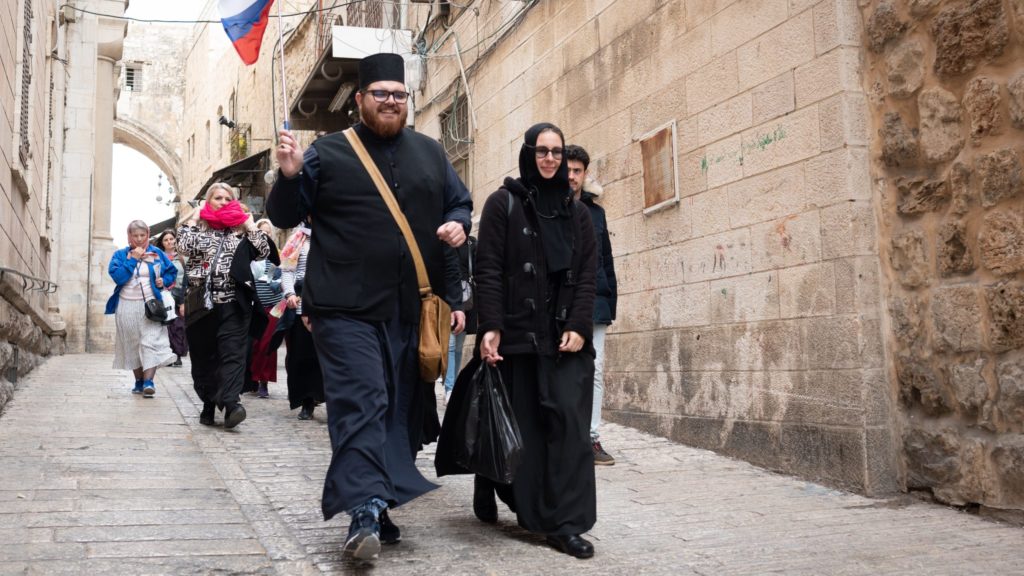Last December's Christmas tree lightings in many towns and cities in Jerusalem finally pointed to a return toward normalcy for Holy Land pilgrim visits and tourism to Israel following the global pandemic and lockdowns beginning in 2020.
But the ongoing war between Russia and Ukraine has presented other setbacks to the local tourism economy and -- as in so many other places worldwide -- the pandemic changed daily living and livelihoods for many throughout the Holy Land, according to the regional director of the Catholic Near East Welfare Association (CNEWA), an agency of the Holy See.
As Israel lifted all bans and restrictions connected with COVID, the country has witnessed a gradual return of tourism, especially in the last quarter of 2022, said Joseph Hazboun, a Palestinian Catholic of the Latin Rite, who has served CNEWA for more than two decades.
"It will take some time before the numbers reach peak levels of 2019, yet this slow return is encouraging, as hotels and pilgrim homes are back in business, hiring or rehiring staff and souvenir shops are back in business, as well as the hundreds of small olivewood factories that have suffered greatly in the past couple of years because of the lack of tourism," Hazboun told the Florida Catholic by email from his office in Jerusalem.
He added that as hotels and pilgrim homes open back up for business, other parts of the economy flourish.
While Christians in Israel are a minority within a minority -- Arab Israeli Christians count for approximately 2.4% of Israel's total population -- the church's social service institutions are numerous and impact all segments of society, Jewish, Christian and Muslim, according to CNEWA.
In an area that suffers a high rate of unemployment in general, the tourism reboot has affected the lives of tour guides, especially students who graduated right before or during the COVID-19 pandemic, according to Hazboun, who pointed out that some of those graduated are now seen entering the Jerusalem-based Pontifical Institute Notre Dame of Jerusalem Center to accompany and guide tourist groups.
"Souvenir shops in Bethlehem and Jerusalem are welcoming busses of tourist groups again. Restaurants, food industries, handicraft workshops are all back in business, with sales up between October and December," Hazboun said. "There are reservations for tour groups and pilgrims visiting the Holy Land for February and beyond."
Hazboun said his brother, a manager of a Christian family souvenir shop in Bethlehem, is once again waking up as early as 6 a.m. to welcome the groups who started returning around last August.
"Relatives and people we know, who owned olivewood factories, and who stopped working during COVID, are now back in business and earning their living with dignity. Hotels are hiring and more young graduates are finding employment," he said.
Hazboun contrasts that with the dark days of the pandemic, when CNEWA and its partner agencies arranged an annual "day of solidarity" for 20 religious and monastic congregations, selling their handicraft and food products to locals and international nonprofit entities present in Israel.
"This year, we were told that since pilgrimages are back, and international volunteers are coming back, there is no need for a special day of solidarity this year," he said.
Still, the tourism outlook is not as robust as it was in 2019, and now the ongoing Russia-Ukraine conflict has created a new dent in the pilgrimage industry in Jerusalem.
Hazboun said he has noticed a reluctance among many Europeans, including German groups in particular, to travel at this time.
"German pilgrimage groups are cautious and reluctant to travel, including visiting the Holy Land, which has a knock-on (domino) effect for all German-based pilgrim homes here, such as the Pilgerhaus in Tiberias and the Paulushaus in Jerusalem," Hazboun said. "The British are also reluctant to go on pilgrimages at this time."
Other European countries find it very risky to invest thousands of euros in pilgrimages when the gas bills have tripled since the Ukraine war began, he said. In addition, Russian and Ukraine pilgrims, once a significant piece of the tourism market in Israel, are now on hold.
There also are lingering impacts of the three years without pilgrim visitors and tourists: Some local handicraft and souvenir workshop owners in the Holy Land who lost their income during COVID-19 are now working as day laborers on construction sites in addition to other manual labor jobs in Israel.
Hazboun worries many tradesmen are unwilling to reopen their souvenir businesses now that they have a stable income working in the construction sector at a time when the cost of gasoline, heating fuel, gas, electricity and water, in addition to basic food supplies, has increased significantly and continues to rise.
"In the Palestinian territories, the cost of medical care or emergency medical conditions is a horrifying concern for the impoverished as all medical expenses are out of pocket," he added, noting that a serious illness can result in families selling major assets or property.
A final communique issued Jan. 19 at the end of the annual pilgrimage of the Holy Land Coordination, which took place in neighboring Jordan, noted that many young Christians, despite facing significant social and economic challenges, remain resolutely committed to enriching both Church and society.
"We encourage pilgrims from our different countries to come and encounter these Christian communities" in the region, the statement read, which was signed by Christian leaders from around the world, including Bishop David J. Malloy of the Diocese of Rockford, Illinois, who is chairman of the U.S. bishops' Committee on International Justice and Peace. "Praying with and learning from the country's Christians -- its 'living stones' -- will serve to expand and strengthen pilgrims’ own faith."
"We commit ourselves to continued prayer and advocacy for our sisters and brothers across Jordan, Palestine, Israel, and the wider region, trusting in God's promise for all who dwell in this land," the letter stated.

